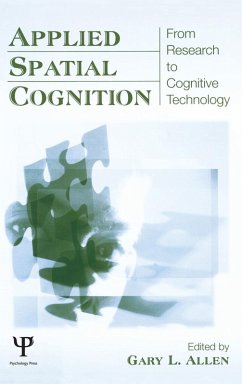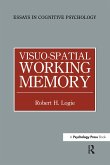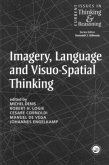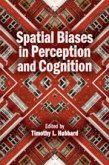Applied Spatial Cognition
From Research to Cognitive Technology
Herausgeber: Allen, Gary L
Applied Spatial Cognition
From Research to Cognitive Technology
Herausgeber: Allen, Gary L
- Gebundenes Buch
- Merkliste
- Auf die Merkliste
- Bewerten Bewerten
- Teilen
- Produkt teilen
- Produkterinnerung
- Produkterinnerung
"Applied Spatial Cognition "illustrates the vital link between research and application in spatial cognition, featuring an impressive vista ranging from applied research to applications of cognitive technology. Chapters throughout the book, which ar
Andere Kunden interessierten sich auch für
![Visuo-spatial Working Memory Visuo-spatial Working Memory]() Robert H LogieVisuo-spatial Working Memory180,99 €
Robert H LogieVisuo-spatial Working Memory180,99 €![Visuo-Spatial Working Memory and Individual Differences Visuo-Spatial Working Memory and Individual Differences]() Cesare CornoldiVisuo-Spatial Working Memory and Individual Differences189,99 €
Cesare CornoldiVisuo-Spatial Working Memory and Individual Differences189,99 €![Handbook of Spatial Research Paradigms and Methodologies Handbook of Spatial Research Paradigms and Methodologies]() Nigel Foreman / Raphael Gillett (eds.)Handbook of Spatial Research Paradigms and Methodologies179,99 €
Nigel Foreman / Raphael Gillett (eds.)Handbook of Spatial Research Paradigms and Methodologies179,99 €![Imagery, Language and Visuo-Spatial Thinking Imagery, Language and Visuo-Spatial Thinking]() Johannes EngelKamp / Robert Logie / Manuel Vega (eds.)Imagery, Language and Visuo-Spatial Thinking180,99 €
Johannes EngelKamp / Robert Logie / Manuel Vega (eds.)Imagery, Language and Visuo-Spatial Thinking180,99 €![Spatial Biases in Perception and Cognition Spatial Biases in Perception and Cognition]() Spatial Biases in Perception and Cognition159,99 €
Spatial Biases in Perception and Cognition159,99 €![Applied Cognitive Psychology Applied Cognitive Psychology]() Paul BarberApplied Cognitive Psychology180,99 €
Paul BarberApplied Cognitive Psychology180,99 €![Basic and Applied Perspectives on Learning, Cognition, and Development Basic and Applied Perspectives on Learning, Cognition, and Development]() Basic and Applied Perspectives on Learning, Cognition, and Development176,99 €
Basic and Applied Perspectives on Learning, Cognition, and Development176,99 €-
-
-
"Applied Spatial Cognition "illustrates the vital link between research and application in spatial cognition, featuring an impressive vista ranging from applied research to applications of cognitive technology. Chapters throughout the book, which ar
Hinweis: Dieser Artikel kann nur an eine deutsche Lieferadresse ausgeliefert werden.
Hinweis: Dieser Artikel kann nur an eine deutsche Lieferadresse ausgeliefert werden.
Produktdetails
- Produktdetails
- Verlag: Taylor & Francis
- Seitenzahl: 414
- Erscheinungstermin: 6. September 2006
- Englisch
- Abmessung: 236mm x 162mm x 27mm
- Gewicht: 680g
- ISBN-13: 9780805852998
- ISBN-10: 0805852999
- Artikelnr.: 22456217
- Herstellerkennzeichnung
- Libri GmbH
- Europaallee 1
- 36244 Bad Hersfeld
- gpsr@libri.de
- Verlag: Taylor & Francis
- Seitenzahl: 414
- Erscheinungstermin: 6. September 2006
- Englisch
- Abmessung: 236mm x 162mm x 27mm
- Gewicht: 680g
- ISBN-13: 9780805852998
- ISBN-10: 0805852999
- Artikelnr.: 22456217
- Herstellerkennzeichnung
- Libri GmbH
- Europaallee 1
- 36244 Bad Hersfeld
- gpsr@libri.de
Gary L. Allen
Contents: Preface. Part I:Influencing Spatial Activity in Real-World and Electronic Environments.T. Gärling
P. Loukopoulos
Choice of Driving Versus Walking Related to Cognitive Distance. M. Denis
P-E. Michon
A. Tom
Assisting Pedestrian Wayfinding in Urban Settings: Why References to Landmarks Are Crucial in Direction-Giving. B. Tversky
M. Agrawala
J. Heiser
P. Lee
P. Hanrahan
D. Phan
C. Stolte
M-P. Daniel
Cognitive Design Principles for Automated Generation of Visualizations. S. Bertel
G. Vrachliotis
C. Freksa
Aspect-Oriented Building Design: Towards Computer-Aided Approaches to Solving Spatial Constraint Problems in Architecture. S. Hirtle
M. Sorrows
Navigation in Electronic Environments. Part II: Assisting Wayfinding
Orientation
and Mobility in Specific Populations. N. Foreman
Spatial Cognition and Its Facilitation in Special Populations. J.M. Loomis
R.G. Golledge
R.L. Klatzky
J.R. Marston
Assisting Wayfinding in Visually Impaired Travelers. J.A. Thomson
Negotiating the Urban Traffic Environment: Pedestrian Skill Development in Young Children. Part III: Training or Facilitating Skilled Performance. J.J. Staszewski
Spatial Thinking and the Design of Landmine Detection Training. C.D. Heth
E.H. Cornell
A Geographic Information System for Managing Search for Lost Persons. M. Hegarty
M. Keehner
C. Cohen
D.R. Montello
Y. Lippa
The Role of Spatial Cognition in Medicine: Applications for Selecting and Training Professionals. S. Guerlain
Software Navigation Design. J.N. Templeman
L.E. Sibert
Immersive Simulation of Coordinated Motion in Virtual Environments: An Application to Training Small Unit Military Tactics
Techniques
and Procedures.
P. Loukopoulos
Choice of Driving Versus Walking Related to Cognitive Distance. M. Denis
P-E. Michon
A. Tom
Assisting Pedestrian Wayfinding in Urban Settings: Why References to Landmarks Are Crucial in Direction-Giving. B. Tversky
M. Agrawala
J. Heiser
P. Lee
P. Hanrahan
D. Phan
C. Stolte
M-P. Daniel
Cognitive Design Principles for Automated Generation of Visualizations. S. Bertel
G. Vrachliotis
C. Freksa
Aspect-Oriented Building Design: Towards Computer-Aided Approaches to Solving Spatial Constraint Problems in Architecture. S. Hirtle
M. Sorrows
Navigation in Electronic Environments. Part II: Assisting Wayfinding
Orientation
and Mobility in Specific Populations. N. Foreman
Spatial Cognition and Its Facilitation in Special Populations. J.M. Loomis
R.G. Golledge
R.L. Klatzky
J.R. Marston
Assisting Wayfinding in Visually Impaired Travelers. J.A. Thomson
Negotiating the Urban Traffic Environment: Pedestrian Skill Development in Young Children. Part III: Training or Facilitating Skilled Performance. J.J. Staszewski
Spatial Thinking and the Design of Landmine Detection Training. C.D. Heth
E.H. Cornell
A Geographic Information System for Managing Search for Lost Persons. M. Hegarty
M. Keehner
C. Cohen
D.R. Montello
Y. Lippa
The Role of Spatial Cognition in Medicine: Applications for Selecting and Training Professionals. S. Guerlain
Software Navigation Design. J.N. Templeman
L.E. Sibert
Immersive Simulation of Coordinated Motion in Virtual Environments: An Application to Training Small Unit Military Tactics
Techniques
and Procedures.
Contents: Preface. Part I:Influencing Spatial Activity in Real-World and Electronic Environments.T. Gärling
P. Loukopoulos
Choice of Driving Versus Walking Related to Cognitive Distance. M. Denis
P-E. Michon
A. Tom
Assisting Pedestrian Wayfinding in Urban Settings: Why References to Landmarks Are Crucial in Direction-Giving. B. Tversky
M. Agrawala
J. Heiser
P. Lee
P. Hanrahan
D. Phan
C. Stolte
M-P. Daniel
Cognitive Design Principles for Automated Generation of Visualizations. S. Bertel
G. Vrachliotis
C. Freksa
Aspect-Oriented Building Design: Towards Computer-Aided Approaches to Solving Spatial Constraint Problems in Architecture. S. Hirtle
M. Sorrows
Navigation in Electronic Environments. Part II: Assisting Wayfinding
Orientation
and Mobility in Specific Populations. N. Foreman
Spatial Cognition and Its Facilitation in Special Populations. J.M. Loomis
R.G. Golledge
R.L. Klatzky
J.R. Marston
Assisting Wayfinding in Visually Impaired Travelers. J.A. Thomson
Negotiating the Urban Traffic Environment: Pedestrian Skill Development in Young Children. Part III: Training or Facilitating Skilled Performance. J.J. Staszewski
Spatial Thinking and the Design of Landmine Detection Training. C.D. Heth
E.H. Cornell
A Geographic Information System for Managing Search for Lost Persons. M. Hegarty
M. Keehner
C. Cohen
D.R. Montello
Y. Lippa
The Role of Spatial Cognition in Medicine: Applications for Selecting and Training Professionals. S. Guerlain
Software Navigation Design. J.N. Templeman
L.E. Sibert
Immersive Simulation of Coordinated Motion in Virtual Environments: An Application to Training Small Unit Military Tactics
Techniques
and Procedures.
P. Loukopoulos
Choice of Driving Versus Walking Related to Cognitive Distance. M. Denis
P-E. Michon
A. Tom
Assisting Pedestrian Wayfinding in Urban Settings: Why References to Landmarks Are Crucial in Direction-Giving. B. Tversky
M. Agrawala
J. Heiser
P. Lee
P. Hanrahan
D. Phan
C. Stolte
M-P. Daniel
Cognitive Design Principles for Automated Generation of Visualizations. S. Bertel
G. Vrachliotis
C. Freksa
Aspect-Oriented Building Design: Towards Computer-Aided Approaches to Solving Spatial Constraint Problems in Architecture. S. Hirtle
M. Sorrows
Navigation in Electronic Environments. Part II: Assisting Wayfinding
Orientation
and Mobility in Specific Populations. N. Foreman
Spatial Cognition and Its Facilitation in Special Populations. J.M. Loomis
R.G. Golledge
R.L. Klatzky
J.R. Marston
Assisting Wayfinding in Visually Impaired Travelers. J.A. Thomson
Negotiating the Urban Traffic Environment: Pedestrian Skill Development in Young Children. Part III: Training or Facilitating Skilled Performance. J.J. Staszewski
Spatial Thinking and the Design of Landmine Detection Training. C.D. Heth
E.H. Cornell
A Geographic Information System for Managing Search for Lost Persons. M. Hegarty
M. Keehner
C. Cohen
D.R. Montello
Y. Lippa
The Role of Spatial Cognition in Medicine: Applications for Selecting and Training Professionals. S. Guerlain
Software Navigation Design. J.N. Templeman
L.E. Sibert
Immersive Simulation of Coordinated Motion in Virtual Environments: An Application to Training Small Unit Military Tactics
Techniques
and Procedures.








